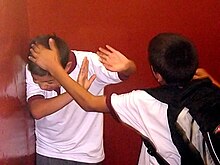
Back التنمر في المدارس Arabic Acosu escolar AST Harellerezh skol Breton Assetjament escolar Catalan Školní šikana Czech Skolemobning Danish Mobbing in der Schule German Σχολικός εκφοβισμός Greek Acoso escolar Spanish Eskola jazarpen Basque

School bullying, like bullying outside the school context, refers to one or more perpetrators who have greater physical strength or more social power than their victim and who repeatedly act aggressively toward their victim.[2][3][4] Bullying can be verbal or physical.[2][3] Bullying, with its ongoing character, is distinct from one-off types of peer conflict.[5] Different types of school bullying include ongoing physical, emotional, and/or verbal aggression. Cyberbullying and sexual bullying are also types of bullying. Bullying even exists in higher education. There are warning signs that suggest that a child is being bullied, a child is acting as a bully, or a child has witnessed bullying at school.[6][7]
The cost of school violence is significant across many nations but there are educational leaders who have had success in reducing school bullying by implementing certain strategies. Some strategies used to reduce or prevent school bullying include educating the students about bullying, restricting of recording devices in the classroom, employing security technology, and hiring school safety officers. How schools respond to bullying, however, varies widely. Effects on the victims of school bullying include feelings of depression, anxiety, anger, stress, helplessness, and reduced school performance[8][9] Empirical research by Sameer Hinduja and Justin Patchin involving a national sample of US youth have found that some victims of school bullying have attempted to commit suicide.[10]
This behavior is not a one-off episode; it must be repetitive and habitual to be considered bullying.[2][3] Students who are LGBTQIA+, have parents of lower educational levels, are thought to be provocative, are perceived to be vulnerable, or are atypical or considered outsiders are at higher risk of being victimized by bullies.[11][12][13][14] Baron (1977) defined such "aggressive behaviour as behaviour that is directed towards the goal of harming or injuring another living being who is motivated to avoid such treatment".[15]
Historically, Thomas Hughes's 1857 novel Tom Brown's School Days details intensive school bullying, but the first major scholarly journal article to address school bullying appears to have been written in 1897.[16] Research in school bullying has dramatically expanded over time, rising from 62 citations in the 90 years between 1900 and 1990, to 562 in the 4 years between 2000 and 2004.[17] Since 2004, research on school bullying has mushroomed. A 2022 South Korean TV series The Glory drew renewed attention to the phenomenon.[18][19]
- ^ U.S. National Center for Education Statistics. Student Reports of Bullying: Results From the 2001 School Crime Supplement to the National Crime Victimization Survey (PDF) (Report).
- ^ a b c Nansel, Tonja R.; Overpeck, Mary; Pilla, Ramani S.; Ruan, W. June; Simons-Morton, Bruce; Scheidt, Peter (25 April 2001). "Bullying behaviors among U.S. youth: Prevalence and association with psychosocial adjustment". JAMA. 285 (16). American Medical Association: 2094–2100. doi:10.1001/jama.285.16.2094. PMC 2435211. PMID 11311098.
- ^ a b c Nansel, Tonja R.; Craig, Wendy; Overpeck, Mary D.; Saluja, Gitanjali; Ruan, W. June (1 August 2004). "Cross-national consistency in the relationship between bullying behaviors and psychosocial adjustment". Archives of Pediatrics & Adolescent Medicine. 158 (8). American Medical Association: 730–736. doi:10.1001/archpedi.158.8.730. PMC 2556236. PMID 15289243.
- ^ Ma, Xin; Stewin, Len L.; Mah, Deveda L. (2001). "Bullying in school: nature, effects and remedies". Research Papers in Education. 16 (3): 247–270. doi:10.1080/02671520126826.
- ^ Burger, C. (2022). "School bullying is not a conflict: The interplay between conflict management styles, bullying victimization and psychological school adjustment". International Journal of Environmental Research and Public Health. 19 (18): 11809. doi:10.3390/ijerph191811809. ISSN 1661-7827. PMC 9517642. PMID 36142079.
- ^ Cite error: The named reference
the United States 2013was invoked but never defined (see the help page). - ^ Cite error: The named reference
Victimologywas invoked but never defined (see the help page). - ^ Halliday, S., Gregory, T., Taylor, A., Digenis, C., Turnbull, D. (2021). "The impact of bullying victimization in early adolescence on subsequent psychosocial and academic outcomes across the adolescent period: A systematic review". Journal of School Violence. 20 (3): 351–373. doi:10.1080/15388220.2021.1913598. ISSN 1538-8220. S2CID 235204391.
- ^ Cite error: The named reference
:1was invoked but never defined (see the help page). - ^ Hinduja, S., Patchin, J. W. (2019). "Connecting adolescent suicide to the severity of bullying and cyberbullying". Journal of School Violence. 18 (3): 333–346. doi:10.1080/15388220.2018.1492417. ISSN 1538-8220. S2CID 150186205.
- ^ Jeffrey, Linda R.; Miller, Demond; Linn, Margaret (2001). "Middle school bullying as a context for the development of passive observers to the victimization of others". Journal of Emotional Abuse. 2 (2–3). Informa UK Limited: 143–156. doi:10.1300/j135v02n02_09. S2CID 145004242.
- ^ Wong, Ching-Tsai; Cheng, Ying-Yao; Chen, Li-Ming (2013). "Multiple perspectives on the targets and causes of school bullying". Educational Psychology in Practice. 29 (3). Informa UK Limited: 278–292. doi:10.1080/02667363.2013.837030. S2CID 145731042.
- ^ Kosciw, J. G.; Greytak, E. A.; Giga, N. M.; Villenas, C.; Danischewski, D. J. (2016). The 2015 National School Climate Survey: The experiences of lesbian, gay, bisexual, transgender, and queer youth in our nation's schools (Report). New York, NY: GLSEN. ERIC ED574780.
- ^ Pervanidou, P.; Makris, G.; Bouzios, I.; Chrousos, G.; Roma, E.; Chouliaras, G. (1 October 2019). "Bullying victimization: Associated contextual factors in a Greek sample of children and adolescents". Psychiatriki. 30 (3). Hellenic Psychiatric Association: 216–225. doi:10.22365/jpsych.2019.303.216. PMID 31685453. S2CID 207897798.
- ^ Baron, R. A. (1977). Human aggression. New York: Plenum. ISBN 978-0-306-31050-8.
- ^ Koo, Hyojin (1 April 2007). "A time line of the evolution of school bullying in differing social contexts". Asia Pacific Education Review. 8 (1): 107–116. doi:10.1007/BF03025837. S2CID 27359151.
- ^ Stassen Berger, Kathleen (March 2007). "Update on bullying at school: Science forgotten?". Developmental Review. 27 (1): 90–126. doi:10.1016/j.dr.2006.08.002.
- ^ Jun-hee, Park (11 January 2023). "Hair curler bullying scene in 'The Glory' stirs memories of similar case from 2006". The Korea Herald.
- ^ Burt, Kayti (10 March 2023). "The Real Stories of Bullying Behind Netflix's 'The Glory'". Time.